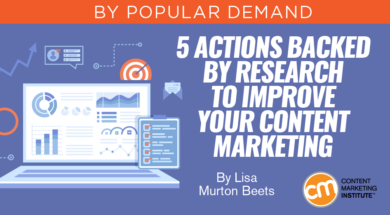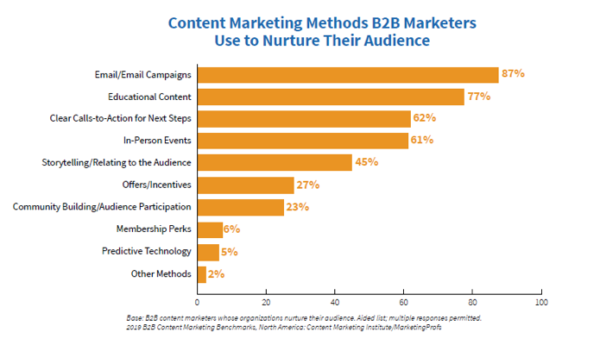
Editor’s note: Because research continues to be one of the most effective cornerstones of content marketing, Lisa Murton Beets updates her 2017 and 2018 articles on the subject.
Heading into the fall is a great time to evaluate your content marketing. How have you done so far this year? If your program isn’t yet where you want it to be, now’s the time to start making some tweaks.
Here are some key takeaways from CMI’s research over the last 12 months to help inform that work.
1. Get to know your audience
CMI and MarketingProfs’ 2018 B2B research revealed that 80% of marketers are focused on building an audience. To do that, content marketers must have an in-depth understanding of the people they’re trying to attract and serve.
How well do you know the audience you have or the audience you want to build? If you’re like many who responded to our surveys, you might have room to improve.
Our 2019 B2B research showed that 55% of content marketers use personas, and only 42% research their audience by having conversations with customers. Instead, they rely primarily on sales team feedback and website analysis.
55% of content marketers use personas, & 42% research their audience by having conversations w/ customers. @cmicontent Click To Tweet
This year, our Content Marketing & Strategy Survey (of marketers involved with strategic content management in their organizations) found that:
- 61% of content professionals are challenged with knowing what is most important to their audiences.
- 50% are challenged with knowing the goal of the audience at a particular stage of the customer’s journey.
- 49% are challenged with knowing the steps in the customer’s journey.
How can you create content that resonates with your audience if you don’t know what people in the audience care about? Instead of hoping for luck, start finding out.
How can you create content that resonates if you don’t know what your audience cares about? @LisaBeets Click To Tweet
What you can do
To build and grow an audience successfully, check how well you understand their needs.
Do you have up-to-date audience personas? If not, create or adjust them. But don’t treat your personas as fixed descriptions – continue to create opportunities to talk directly to customers. Listen in on calls with customer success or sales teams to hear what your audience is asking and which words they use to describe their needs.
Check out these recent articles for more ideas and recommendations:
2. Lead with the audience’s needs and interests (not your brand’s)
This step should be obvious. Your audience cares about their needs – your brand messaging isn’t a priority for them. If you still doubt this point, consider that 90% of those who consider their content marketing successful say they put the audience’s informational needs ahead of their sales/promotional messages. Only 56% of those who feel the least successful with content marketing say they put the audience’s needs first.
Sure, at some point, B2B buyers want and need your product and company information. The trick is to offer the right kind of information at the right time.

What you can do
Make sure your content fills an informational need for your audience, not just a marketing need for your brand. Think about what your audience members need when they research a problem, consider or compare solutions, make a purchase, or come back for more.
In other words, consider where your audience is in its journey. Just remember that it directs the journey – you don’t.
Your audience directs its journey – you don’t. @LisaBeets #Research Click To Tweet
“Stop thinking of your buyers walking a straight path to purchase,” Ann Gynn writes in this helpful article about non-linear buyer journeys. “Instead, consider what type of information your potential buyers and customers need at every stage and create stage-specific content in a mix of formats. Then make it accessible when and where your buyer is ready to consume it.”
Stop thinking of your buyers walking a straight path to purchase, says @AnnGynn. Click To Tweet
Check out these resources to understand how to create audience-first content, to find and fix gaps in the content you have for each stage, and to measure whether that content connects:
3. Go beyond email to build relationships
Most of us have a love-hate relationship with email. As marketers, we love it: 87% of content marketers who took our ninth annual survey said they use email to nurture their audiences.
87% of #content marketers say they use #email to nurture their audiences. @LisaBeets #Research Click To Tweet
And yet, as consumers we’re reminded every day how overwhelming it can be on the receiving end of all that email marketing.

What you can do
First, respect your audience’s inbox or pay the price, says Michael Barber, chief creative officer at Godfrey:
Every time we deliver a message to the inbox – whether it’s transactional, promotional, or a newsletter – and we’re not as timely, targeted, and relevant as possible, we’re slowly erasing the relationship [we’ve built]. That can create a challenge to repair later on.
Respect your audience’s inbox or pay the price, says @michaeljbarber. #emailmarketing Click To Tweet
You can read more of Michael’s advice in this CCO article or watch highlights of his recent talk at ContentTECH Summit:
Email marketing isn’t going anywhere. But plenty of other opportunities exist to develop relationships with your audience. Here are a few:
- Create a community. Study these tips from CMI’s community manager par excellence Monina Wagner to build a meaningful online neighborhood.
- Host in-person events. Live events give you the opportunity to talk to your audience and initiate relationships. To get your audience to attend, review these pre-event marketing ideas from CMI General Manager Stephanie Stahl.
- Keep an eye on changing preferences. Given the fierce competition in inboxes these days, you might consider experimenting with other channels, such as the blend of email and SMS messaging Ardath Albee described.
- Always offer somewhere to go. Don’t leave your audience hanging – invite them to take the next step by offering relevant CTAs.
4. Win (and keep) audience trust
People increasingly want to do business with companies they trust and they’re certainly more likely to recommend a company they trust.
That’s one of the reasons we asked content marketers whether their audience views their company as a trusted resource. Our finding: 96% of content marketers who report great success say their audience does. And there’s more good news: 68% of all content marketers surveyed say they successfully used content marketing to build credibility with their audience in the last 12 months.
96% of content marketers who report great success say their audience trusts them as resource. @CMIContent #research Click To Tweet
What you can do
CMI’s chief strategy advisor, Robert Rose, says everything you do should create or reinforce trust with your audience: “Every digital experience we create should not only reflect our focus on winning a moment of truth – where the customer is paying attention – but in deepening the trust gained (or regained) in every step that precedes or follows it.”
There is no single moment of truth. There are hundreds or thousands of moments of trust, says @Robert_Rose. Click To Tweet
Earning that trust requires your content to have four traits, as Robert details them:
- Risk appropriate (avoid asking for something before proving the value)
- Consistent (deliver reliable content regularly over time)
- Personal (based on reliable information the visitor has willingly given)
- Cumulative (building on what came before)
How do you know whether your audience trusts you? Aaron Agius offers these tips:
- Set up a Google Alert for your company to see how it’s portrayed in the news.
- Check appropriate review sites to read what customers say about your company.
- Monitor company mentions on social media.
- Send an audience survey.
- Determine your Net Promoter Score (how likely a customer would be to recommend your business).
Read the rest of Aaron’s article for ideas on how to build trust in your brand.
Monitor how well your audience trusts your brand by checking out review sites @trustpilot or @yelp. @IAmAaronAgius Click To Tweet
5. Get your SEO house in order
If you think it seems like there’s new SEO advice every week, you’re not alone. More survey respondents mentioned changes to SEO/search algorithms as a top content marketing concern than any other issue: 61% mentioned SEO, 45% named social media algorithms, and 41% chose content marketing as a revenue center.
What you can do
We asked Content Marketing World 2018 speakers what to do when search algorithms change. Their advice turned out to be evergreen. TL;DR? Don’t panic, don’t rush, and test everything.
But do review current SEO thinking and adjust your strategies as needed. Here are some places to start:
The main thing to keep in mind? Focus on creating great content. Build relationships that help you truly know what your audience wants and needs. Spot-on content, coupled with smart strategy and distribution, are the tickets to engagement, trust, and business results.
What’s ahead for content marketers? We will begin revealing the findings of our latest content marketing survey at Content Marketing World in September. Register today to attend and be among the first to hear. Use code BLOG100 to save $100.
To make sure you get the results of the latest research on content marketing in B2B, B2C, tech, manufacturing and other segments, please subscribe to receive our email updates.
Cover image by Joseph Kalinowski/Content Marketing Institute
